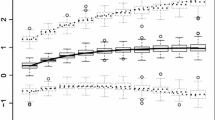Abstract
Several statistical functionals such as quantiles and expectiles arise naturally as the minimizers of the expected value of a scoring function, a property that is called elicitability (see Gneiting in J Am Stat Assoc 106:746–762, 2011 and the references therein). The existence of such scoring functions gives a natural way to compare the accuracy of different forecasting models, and to test comparative hypotheses by means of the Diebold–Mariano test as suggested in a recent work. In this paper we suggest a procedure to test the accuracy of a quantile or expectile forecasting model in an absolute sense, as in the original Basel I backtesting procedure of value-at-risk. To this aim, we study the asymptotic and finite-sample distributions of empirical scores for normal and uniform i.i.d. samples. We compare on simulated data the empirical power of our procedure with alternative procedures based on empirical identification functions (i.e. in the case of VaR the number of violations) and we find an higher power in detecting at least misspecification in the mean. We conclude with a real data example where both backtesting procedures are applied to AR(1)–Garch(1,1) models fitted to SP500 logreturns for VaR and expectiles’ forecasts.













Similar content being viewed by others
References
Acerbi C, Szekely B (2014) Backtesting expected shortfall. Risk Mag 27:76–81
Artzner P, Delbaen F, Eber JM, Heath D (1999) Coherent measures of risk. Math. Finance 9(3):203–228
Bellini F (2012) Isotonicity results for generalized quantiles. Stat Prob Lett 82:2017–2024
Bellini F, Bignozzi V (2014) On elicitable risk measures. Quant Finance 15:725–733
Bellini F, Di Bernardino E (2017) Risk management with expectiles. Eur J Finance 23(6):487–506
Bellini F, Klar B, Muller A (2014) Generalized quantiles as risk measures. Insur Math Econ 54:41–48
Berkowitz J (2001) Testing the accuracy of density forecasts, applications to risk management. J Bus Econ Stat 19:465–474
Campbell SD (2005) A review of backtesting and backtesting procedures. Finance and Economics Discussion Series, Federal Reserve Board, 21
Christoffersen PF (1998) Evaluating interval forecasts. Int Econ Rev 39:841–862
Christoffersen PF, Pelletier D (2004) Backtesting value-at-risk: a duration-based approach. J Financ Econom 2:84–108
Corbetta J, Peri I (2016) A new approach to backtesting and risk model selection. Preprint, ssrn.com/abstract=2796253
Delbaen F, Bellini F, Bignozzi V, Ziegel J (2016) Risk measures with the CxLS property. Finance Stoch 20(2):433–453
Ehm W, Gneiting T, Jordan A, Krüger F (2016) Of quantiles and expectiles: consistent scoring functions, Choquet representations and forecast rankings. J R Stat Soc Ser B 78(3):505–562
Fissler T, Ziegel JF (2016) Higher order elicitability and Osband’s principle. Ann Stat 44(4):1680–1707
Fissler T, Ziegel JF, Gneiting T (2016) Expected shortfall is jointly elicitable with value at risk—implications for backtesting. Risk Mag 2016:58–611
Gneiting T (2011) Making and evaluating point forecasts. J Am Stat Assoc 106:746–762
Holzmann H, Eulert M (2014) The role of the information set for forecasting—with applications to risk management. Ann Appl Stat 8(1):595–621
Kerkhof J, Melenberg B (2004) Backtesting for risk-based regulatory capital. J Bank Finance 28:1845–1865
Kupiec P (1995) Techniques for verifying the accuracy of risk measurement models. J Deriv 3:73–84
Lopez JA (1999a) Evaluation of value-at-risk models. J. Risk 1:37–64
Lopez JA (1999b) Methods for evaluating value-at-risk models. Federal Reserve Bank San Franc Econ Rev 2:3–17
Macneil AJ, Frey R (2000) Estimation of tail-related risk measures for heteroschedastic financial time series: an extreme value approach. J Empir Finance 7:271–300
Newey W, Powell J (1987) Asymmetric least squares estimation and testing. Econometrica 55(4):819–847
Nolde N, Ziegel J (2016) Elicitability and backtesting. Preprint. arXiv:1608.05498
Saerens M (2000) Building cost functions minimizing to some summary statistics. IEEE Trans Neural Netw 11:1263–1271
Thomson W (1979) Eliciting production possibilities from a well-informed manager. J Econ Theory 20(3):360–380
Weber S (2006) Distribution-invariant risk measures, information and dynamic consistency. Math Finance 16:419–441
Wong WK (2010) Backtesting value-at-risk based on tail losses. J Empir Finance 17:526–538
Acknowledgements
The authors thank an anomimous referee that with her or his comments and remarks has contributed to improve the quality of the paper.
Author information
Authors and Affiliations
Corresponding author
Appendix
Appendix
We report in this Appendix the explicit computation of the expected values and variances of piecewise linear and quadratic scores and identification function in the normal and uniform cases. That is, we compute the quantities \(E[S^{(v)}(x,Y)]\), \(E\left[ S^{(e)}(x,Y)\right] \), \(E[I^{(v)}(x,Y)]\), \(E[I^{(e)}(x,Y)]\) and the corresponding variances when \(Y\sim N(0,1)\) and \(Y \sim U(0,1)\). We denote with \(\phi (x)\), \(\varPhi (x)\) and \({\overline{\varPhi }}(x)\) the density, the cumulative and the retro-cumulative function of a standard normal r.v.
The following identities will be repeatedly used:
Piecewise linear score, normal case
When \(x=z_{\alpha }\), we get
When \(x=z_{\alpha }\), we get
Piecewise quadratic score, normal case
Now we have for the first term:
Similarly for the second term:
Summing up, we get
When \(x=e_{\alpha }\), we get
Identification function, normal case. Recall that
Since \(E[I^{(e)}(Y,e_\alpha )] =0\), we get
Let now \(Y\sim U(0,1)\), \(\phi (y)=1_{[0,1]}\), \(\varPhi (y)=y1_{[0,1]}\) and \(z_{\alpha }=\alpha \).
Piecewise linear score, uniform case.
Piecewise quadratic score, uniform case. Recall that if \(Y\sim U(0,1)\)
Substituting (9) we get
Note the relationship
Identification function, uniform case.
Rights and permissions
About this article
Cite this article
Bellini, F., Negri, I. & Pyatkova, M. Backtesting VaR and expectiles with realized scores. Stat Methods Appl 28, 119–142 (2019). https://doi.org/10.1007/s10260-018-00434-w
Accepted:
Published:
Issue Date:
DOI: https://doi.org/10.1007/s10260-018-00434-w




